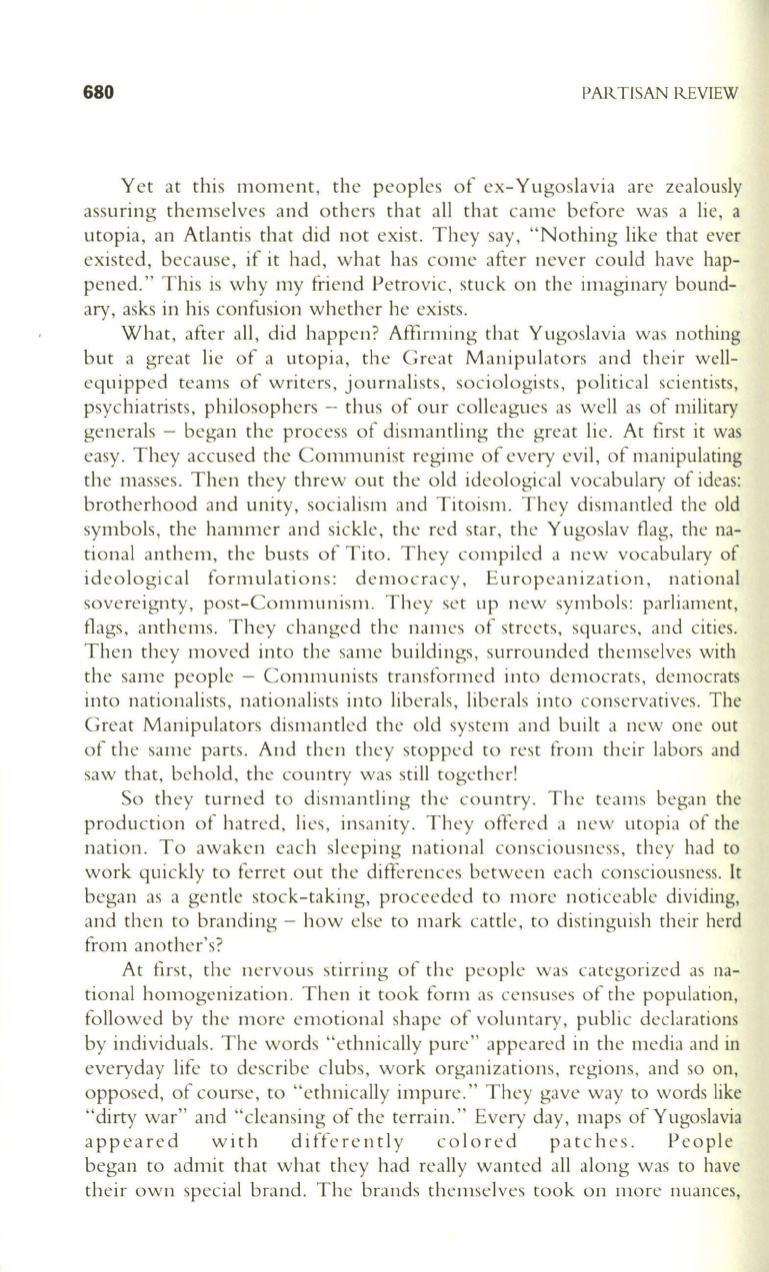
680
PAH.TISAN REVIEW
Yet at this moment, the peoples of ex-Yugoslavia are zealously
assuring themselves and others that all that came before was a lie, a
utopia, an Atlantis that did not exist. They say, "Nothing like that ever
existed, because, if it had, what has come after never could have hap–
pened." This is why my friend Petrovic, stuck on the imaginary bound–
ary, asks in his confusion whether he exists.
What, after all, did happen? Affirming that Yugoslavia was nothing
but a great lie of a utopia, the Great Manipulators and their well–
equipped teams of writers, journalists, sociologists, political scientists,
psychiatrists, philosophers - thus of our colleagues as well as of military
generals - began the process of dismantling the great lie. At first it was
easy. They accused the Communist regime of every evil, of manipulating
the masses. Then they threw out the old ideological vocabulary of ideas:
brotherhood and unity, socialism and Titoism. They dismantled the old
symbols, the hammer and sickle, the red star, the Yugoslav flag, the na–
tional anthem, the busts of Tito. They compiled a new vocabulary of
ideological formulations: democracy, Europeanization, national
sovereignty, post-Communism. They set up new symbols: parliament,
flags, anthems. They changed the names of streets, squares, and cities.
Then they moved into the same buildings, surrounded themselves with
the same people - Communists transformed into democrats, democrats
into nationalists, nationalists into liberals, liberals into conservatives. The
Great Manipulators dismantled the old system and built a new one out
of the same parts. And then they stopped to rest from their labors and
saw that, behold, the country was still together!
So they turned to dismantling the country. The teams began the
production of hatred, lies, insanity. They offered a new utopia of the
nation. To awaken each sleeping national consciousness, they had
to
work quickly to ferret out the differences between each consciousness. It
began as a gentle stock-taking, proceeded to more noticeable dividing,
and then to branding - how else to mark cattle, to distinguish their herd
from another's?
At first, the nervous stirring of the people was categorized as na–
tional homogenization. Then it took form as censuses of the population,
followed by the more emotional shape of voluntary, public declarations
by individuals. The words "ethnically pure" appeared in the media and in
everyday life to describe clubs, work organizations, regions, and so on,
opposed, of course, to "ethnically impure." They gave way to words like
"dirty war" and "cleansing of the terrain." Every day, maps of Yugoslavia
appeared with differently colored patches. People
began to admit that what they had really wanted all along was to have
their own special brand. The brands themselves took on more nuances,


